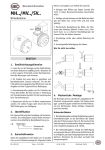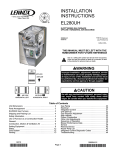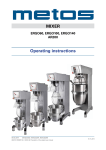Download Troubleshooting tips Appendix 9:
Transcript
Appendix 9: Troubleshooting tips These troubleshooting tips provide basic guidance on how to rectify some common water quality problems. Conduct a risk assessment and seek further information before making any major changes to your water system. Consult the Australian Drinking Water Guidelines for more details on contaminants. We also used the Water Quality Complaint Investigator’s Field Guide (Lauer 2005). Use the key below to find what might be causing your water quality problem and then look up the corresponding entry in the ‘Look up’ column. If the level of any contaminant is extreme, do not drink the water and consult the emergency poster. Troubleshooting tips—Key What colour is the water? Look up Blue or green Copper Brown or black Manganese Reddish-orange Iron Yellowish-brown or tea-coloured Tannins Water has a white milky appearance that disappears with time Air in water Water is opaque and cloudy with fine particles that settle to the bottom Turbidity Does the water leave a deposit, scale or scum? Look up Soap scum, bathtub rings, whitish scale on shower roses and other hardware Hard water or Calcium carbonate Foam/bubbles on water surface Surfactants Red-brown stains and crusting Iron Blue or green stains on porcelain Copper Green or brown organic slime Slime What does the water smell like? Look up Bleach Chlorine Musty or earthy Algae Rotten eggs Hydrogen sulfide Sewage Backflow or Cross-connection Sweet chemical solvent Petrochemicals What does the water taste like? Look up Bitter Calcium carbonate Salty Total dissolved solids Sour Acid Metallic Iron or Copper or Manganese (metals). See also Acid Other Known source of lead contamination Look up Lead Community Water Planner field guide 41 Troubleshooting tips for common water quality problems Acid (pH below about 6.5) Caused by Sour tasting. Acidic groundwater or surface water. Can corrode copper and iron pipes, which causes the water to become discoloured and taste metallic. Air in water Consult a water specialist about adjusting the pH. Caused by What to do Tiny bubbles of air in the water supply system. Air can enter after mains repairs, through a faulty air valve, or because of a poorly functioning pump. Changes in pressure or temperature can cause air bubbles to form (cold water can hold more dissolved air than hot water; water under high pressure holds more air than under low pressure). Water with air bubbles is fine to drink. Bubbles will clear if water is allowed to stand in an open container. Flush the pipe to let the air escape. Check that air-relief valves are working. Check that pump pressure and flow rates are normal. Service the pump if required. Make sure pipes are buried to keep them cool. Caused by What to do Algae growing in the storage tank. Clean the tank. Kill the algae using an algaecide. Stop sunlight getting in to the tank and keep lids secured. Algae in the reservoir. Use an offtake point away from the algae. Consider aeration. Check for any new sources of nutrient contamination (e.g. sewage or fertiliser). Algae in the pipes. Keep water flowing through the pipes —stop water standing in pipelines. Backflow Caused by What to do Water smells or tastes bad; contaminated water is in mains pipework. Contaminated water can get sucked back into the mains pipework if there is no air gap between, for example, a hose and a horse trough. Make sure there is an air gap between any hoses/taps and sources of contaminated water. Consult a plumber if a backflow prevention device needs to be fitted. Calcium carbonate (CaCO3 ) Caused by What to do Calcium carbonate leaching into water from new cement pipes. Flush periodically, especially before drinking the water. The problem should ease over time. Groundwater with naturally high concentrations, such as groundwater from limestone. Consult a water specialist about dosing with acid. Milky appearance that clears with time from the bottom of the container up. Algae Musty or earthy smell. High levels of calcium carbonate can make water alkaline (pH above about 7.5). Water has a bitter taste and metals and minerals precipitate out. See also: Hard water 42 What to do Chlorine (Cl) Caused by What to do Excess chlorine has been added to water through equipment failure, operator error or sudden change in raw water quality. Leave water with too much chlorine for a few days and test again. Exposure to air or heat will remove the chlorine. Copper (Cu) Caused by What to do Green- or blue-coloured water causing green or blue stains. Copper from pipework leaching into water. Even low concentrations of copper can stain white porcelain. Flush the pipes before drinking the water, especially if the water has been standing in the pipes for a long time. Improperly installed plumbing or defective pipe materials. Copper hotwater pipes in a concrete slab need room to expand and contract. Insulate at connections if pipe materials are dissimilar. Consult a plumber. Cross-connection Caused by What to do Unpleasant tastes/odours; contaminated water mixed with mains water. Accidental connection of mains pipes with other pipes (e.g. sewage pipes). Do not drink the water. Consult a plumber. Ensure all pipework is correctly marked. Hard water Caused by What to do Soap forms curds and rings on bathtub and will not lather. High calcium and magnesium in groundwater. Detergents work better than soaps in hard water. Look for detergents that say ’works in hard water’. Clean kettles and fittings with vinegar. Hydrogen sulfide (H2 S) Caused by What to do Rotten-egg, swampy smell. Anaerobic (no oxygen) condition in bore promoting growth of sulfurreducing bacteria. Return the bore to aerobic conditions. Chlorinate the bore. Anaerobic conditions in surface water promoting algal and bacterial growth. Mix water to aerate; kill algae with algaecide. Consider alternative offtake points. Unpleasant ‘bleach’ taste. Community Water Planner field guide 43 Iron (Fe) Caused by What to do Metallic taste, red rust stains. Rusting reservoir or iron piping. Metal pipe with corrosive water and no internal lining to protect against corrosion. Flush pipelines clean. Replace with plastic or PVC pipe when possible. If pH is very acidic, consider consulting a water specialist about correcting pH. Water naturally high in iron. Iron bacteria could also be present; they form a brown sticky gelatinous slime. The bacteria cause odours and clog bores. To reduce iron in bore water, aerate the water and allow the iron to settle out before distribution. If iron bacteria are present, chlorinate and clean the bore. Lead (Pb) Caused by What to do Lead dissolved in water has no taste or smell. Laboratory tests are needed to find out if lead is present. Lead can be a problem in corrosive water supplies if pipes or solder are made from lead. Flush water before drinking to remove any build up of lead from pipe corrosion. Replace lead pipes or solder. Rainwater tanks can be contaminated by lead dust, paint or lead flashing. Stormwater pipes/fittings are not designed for potable water and may contain lead. Discard rainwater contaminated by lead and clean sediment out of the tank. Replace lead paint or flashing. Check all pipework/fittings are suitable for drinking water (See Australian Standard AS 4020). Manganese (Mn) Caused by What to do Bitter metallic taste, dark-brown or black stains, sometimes black ooze sloughing off pipes. Manganese occurs naturally in the ground and in surface water, especially near decaying organic matter. Manganese deposits can be released under anaerobic conditions. Consider aeration followed by filtration. Petrochemicals Caused by What to do Petrochemicals spilt onto plastic pipes, dissolving them. Replace affected pipes. Petrol, pesticides or other chemicals spilt in water supply. If chemicals have spilt into supply: SEE EMERGENCY POSTER. Caused by What to do Slime growing inside pipes can come free if the water pressure increases or chlorine is suddenly increased. Flush the pipes. Maintain chlorine residual to prevent growth. Sediment in storage tank is disturbed. Make sure storage tank sludge is cleaned regularly. Keep lid on tank. Unpleasant chemical taste; sometimes a multicoloured slick on surface of water. Slime Slime (biofilm) in water supply. 44 Surfactants Caused by What to do Bubbly, foamy appearance on the surface of the water source. Natural foam can have a yellowbrown colour and dissipates more quickly than white foam from human activity. Fatty acids and other natural organic matter which is released when vegetation decays. Usually no action needed. Detergents from human activity. Locate the source and prevent further contamination. Tannins Caused by What to do Tannins (phenolic compounds, humic acids) leach into streams and dams as trees, leaves and other vegetation breaks down. Consult a water quality specialist about treatment options such as activated carbon. Caused by What to do Groundwater with high levels of salt. Near the coast, shallow bores can go salty if too much freshwater is drawn and saltwater from the sea intrudes. Drink from an alternative supply. Caused by What to do Small particles in the water supply— algae, stirred-up sediment and clay after rain. Turbidity can reduce the effectiveness of chlorination and UV disinfection. Allow the water to settle before drinking it. Check that disinfection is effective. Tea-coloured or brownyellow water. Total dissolved solids (TDS) Salty taste; white crusts or spots on hardware. Turbidity Water looks cloudy. Community Water Planner field guide 45
















